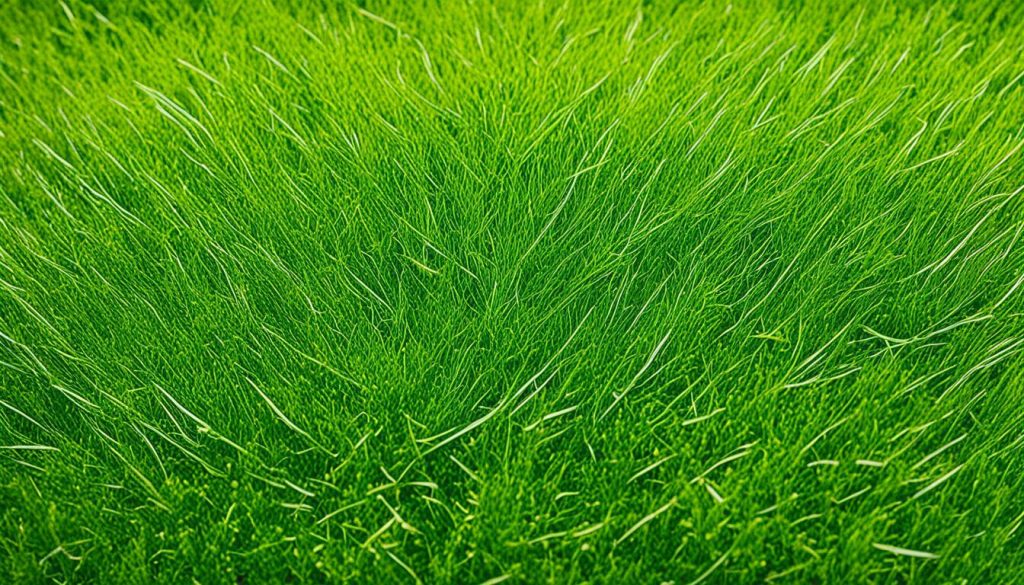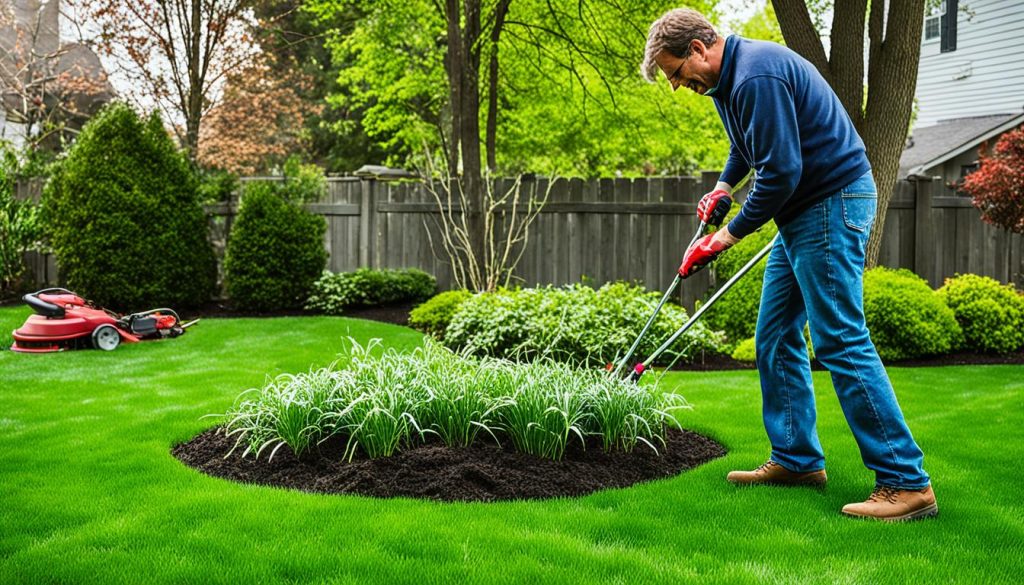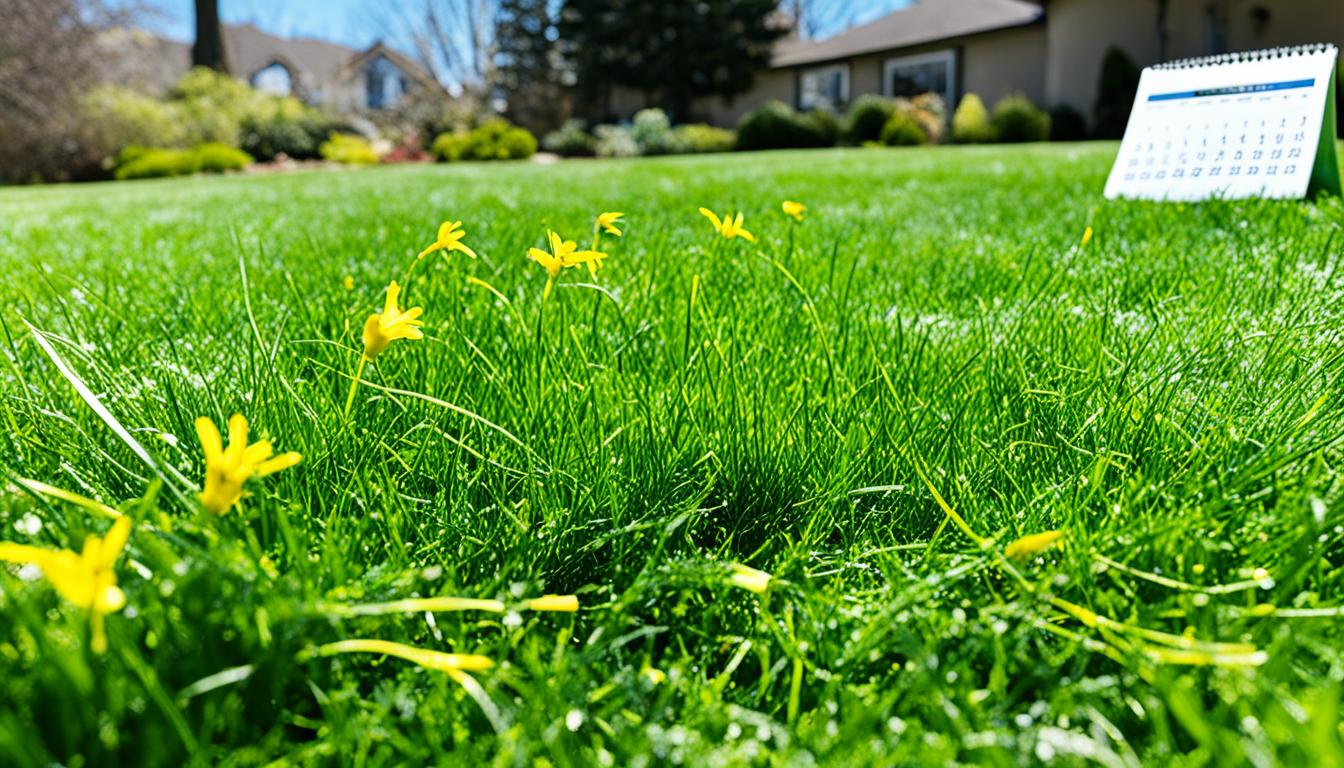Are you tired of battling stubborn weeds in your lawn? Have you ever wondered when is the best time to apply weed killer for maximum effectiveness? Timing is everything when it comes to weed control. Getting the timing right can mean the difference between a weed-free lawn and a frustrating battle against unwanted plants.
In this article, we’ll explore the optimal times to apply weed killer based on various factors, such as weather conditions, weed species, and the life cycle of the weeds. Whether you’re dealing with dandelions, crabgrass, or other common lawn weeds, understanding the right timing can help you achieve the best results.
Key Takeaways:
- Timing is crucial when applying weed killer for effective weed control.
- Spring and fall are the best seasons to target weeds, while summer and winter are less optimal.
- Weather conditions, such as moisture and temperature, affect the effectiveness of weed killers.
- Identifying the specific weed species and its life cycle is essential for targeting weeds at their most vulnerable stage.
- Consider safer alternatives like Foamstream for weed control, which can be used throughout the year.
Factors Affecting Weed Killer Effectiveness
The effectiveness of weed killers can be influenced by several factors. These include the time of year, weather conditions, and the specific weed species and their life cycles.
In terms of timing, the best time to apply weed killer is during the spring when weeds are in their pre-growth state. This is when they are most vulnerable and easier to control. Alternately, fall is another effective season for weed control due to the sudden change in weather.
Weather conditions also play a significant role in weed killer effectiveness. Herbicides require moisture in the soil to activate properly, and rainy seasons like spring provide the necessary moisture for herbicides to be absorbed by the plant root.
Moreover, the type of weed and its life cycle can impact the timing of weed killer application. Different weeds have different growth patterns, some appearing in the fall and winter and dying off in the spring and summer, while others follow the opposite pattern. Additionally, certain weeds may take multiple years to complete their life cycle.
Understanding these factors can help maximize the effectiveness of weed killers and ensure successful weed control. Now let’s explore the best conditions for applying weed killer in the next section.
Factors Affecting Weed Killer Effectiveness
| Factors | Description |
|---|---|
| Time of Year | The best time to apply weed killer is during the spring or fall when weeds are most vulnerable. |
| Weather Conditions | Rainy seasons provide adequate moisture for herbicides to be absorbed by the plant roots. |
| Weed Species and Life Cycles | The specific weed species and their life cycles determine the optimal timing of weed killer application. |
Best Conditions for Applying Weed Killer
When applying weed killer to your lawn, timing is crucial for optimal results. However, there are also specific conditions that can enhance the effectiveness of weed killer. Here are the best conditions to consider:
Avoid Rain Within Six Hours
It is advisable to avoid applying weed killer when rain is expected within six hours. Rain can dilute the herbicide, reducing its potency and effectiveness. Applying weed killer when rain is not predicted ensures that the herbicide stays concentrated and has the maximum effect on the targeted weeds.
Choose Calm Weather
Applying weed killer on a calm day is ideal to prevent the spray from being blown away from the intended area. Windy conditions can cause the herbicide to drift onto neighboring plants or areas where you don’t want it. By choosing a calm day, you can ensure that the weed killer reaches the targeted weeds without causing unintended damage.
Consider Mild Weather
Extreme temperatures can impact the efficacy of weed killers. When it’s hot and dry, the absorption of herbicides into the plants can be reduced. This can result in reduced weed control. On the other hand, cold weather slows down plant metabolism, which can prolong the time it takes for the herbicide to kill the weeds. Therefore, it is best to apply weed killer during mild weather conditions, when the temperature is neither extremely hot nor extremely cold.
By following these best conditions for applying weed killer, you can increase the effectiveness of the herbicide and achieve the best results in weed control.
Impact of Weed Type on Weed Killer Effectiveness
Different weed species can have varying impacts on the effectiveness of weed killers. The life cycle of a weed plays a vital role in determining the best time to apply weed killer for optimal results. Understanding the characteristics of different weeds and their life cycles is crucial for effectively targeting them at their most vulnerable stages.
Some weeds grow during the fall and winter seasons and die off in the spring and summer, while others exhibit the opposite pattern. Certain weeds have longer life cycles, taking two years to complete, while others are perennial and return year after year. The timing of weed killer application should align with the specific life cycle of the targeted weed to increase the chances of successful eradication.
By accurately identifying the weed species and considering their life cycles, you can apply the weed killer during the period when the weeds are most susceptible. This strategic approach ensures that the weed killer directly impacts the growth and development of the weeds, increasing its overall effectiveness.
The impact of weed type on weed killer effectiveness can be summarized as follows:
- Timing is essential for targeting weeds at their most vulnerable stages.
- Understanding the life cycles of different weed species is crucial for effective application.
- Applying weed killer during the period when the weed is actively growing ensures better penetration and absorption.

Visual depiction showcasing the impact of weed type on the effectiveness of weed killer.
Treatment Cycles for Weed Control
Completely eliminating weeds from your lawn requires a strategic approach that involves multiple treatments, known as treatment cycles. These cycles consist of applying weed killers at different stages of weed growth to effectively remove them. Pre-emergent weed killers target weeds before they germinate, while post-emergent weed killers are applied when weeds are actively growing.
Multiple treatments are usually necessary to fully control and eliminate weeds. Each treatment cycle targets different weed populations, ensuring comprehensive and long-lasting weed control. By using a combination of pre-emergent and post-emergent weed killers, you can tackle weeds at various stages of their lifecycle and prevent new ones from taking hold.
However, it’s important to consider the potential risks associated with herbicide-based weed killers. Overexposure to these products can be harmful to both human health and the surrounding vegetation. To address these concerns, many homeowners are turning to herbicide-free alternatives like Foamstream for safer weed control.
Foamstream is an innovative weed control method that uses heated foam to eliminate weeds. It is a safer alternative to traditional herbicides as it doesn’t pose the same risks to human health and the environment. Additionally, Foamstream can be used throughout the year without being affected by external factors like weather conditions or the life cycle of plants.
Maintaining a regular treatment cycle using Foamstream can keep your lawn weed-free with just three treatments per year, significantly reducing the need for multiple applications. This not only saves you time and effort but also promotes a healthier and safer environment for you and your family.
| Treatment Cycles for Weed Control | Advantages |
|---|---|
| Multiple treatments using pre-emergent and post-emergent weed killers | Comprehensive weed control at different stages of growth |
| Herbicide-free alternative like Foamstream | Safer for human health and the environment |
| Three treatments per year | Minimal application required for effective weed control |
By incorporating treatment cycles into your weed control routine and exploring alternative methods like Foamstream, you can achieve a weed-free lawn while minimizing potential risks associated with traditional herbicide-based products.
Foamstream as an Effective Weed Killer
Foamstream is a herbicide-free weed killer that offers consistent effectiveness throughout the year. Unlike herbicide-based weed killers, Foamstream is not affected by external conditions such as season, weather, or the life cycle of plants. It can be used all year round and requires only three treatments per year to keep weeds under control. Other herbicide-free methods like hot water, steam, and boiling require more frequent treatments. Foamstream provides a convenient and safer solution for weed control.
When it comes to weed control, Foamstream stands out as an effective and sustainable option. This innovative weed killer uses a unique foam-based technology to target and eliminate weeds without the need for harmful chemical herbicides. The foam coats the leaves and stems of the weeds, suffocating them and preventing their growth.
One of the key advantages of Foamstream is its year-round effectiveness. Unlike traditional herbicides that may be influenced by factors like seasonal changes or the life cycle of plants, Foamstream delivers reliable results regardless of external conditions. Whether it’s spring, summer, fall, or winter, Foamstream can be used consistently to keep weeds at bay.
Another benefit of Foamstream is its minimal treatment requirements. With just three treatments per year, you can effectively control weeds and maintain a weed-free environment. This makes Foamstream a cost-effective solution compared to other herbicide-free methods that may require more frequent treatments.
Using Foamstream for weed control also provides peace of mind in terms of safety. Since it is herbicide-free, Foamstream poses fewer risks to human health and the environment. It eliminates the need to handle or be exposed to potentially harmful chemicals, making it a safer option for both the applicator and those in the surrounding area.
With its consistent effectiveness, minimal treatment requirements, and safety benefits, Foamstream is a recommended choice for anyone looking to control weeds in a sustainable and eco-friendly way. Say goodbye to harmful chemicals and embrace the power of Foamstream for effective weed control.
Importance of Cultural Practices for Weed Management
Maintaining a thick and healthy lawn is essential for effective weed management. By implementing proper cultural practices, you can significantly minimize weed growth and maintain a weed-free lawn. Cultural practices focus on creating an environment that is unfavorable for weed establishment, reducing the need for herbicides. Let’s explore some key cultural practices for effective weed management:
Proper Soil Fertility
Ensuring proper soil fertility is crucial for a healthy lawn. Well-fertilized soil promotes strong grass growth, which competes with weeds for resources. Conducting regular soil tests can help you determine the specific nutrient requirements of your lawn and make informed decisions about fertilizer application.
Soil pH and Compaction Management
Optimal soil pH levels are necessary for healthy turf. Most grass species prefer slightly acidic soil with a pH range of 6.0 to 7.0. Adjusting the soil pH through lime application can create an environment that favors grass growth while discouraging weed development. Additionally, managing soil compaction through aeration improves root development and grass health, creating a denser lawn that inhibits weed establishment.
Appropriate Watering Practices
Proper watering practices help maintain a healthy lawn while minimizing weed germination. Overwatering can create excess moisture, promoting weed growth. Deep and infrequent watering, preferably in the early morning, allows the grass roots to develop deeper and compete with weeds effectively.
Correct Mowing Techniques
Mowing at the proper height is essential for preventing weed invasion. Each grass species has an ideal mowing height, which varies depending on factors such as climate and grass variety. By following the recommended mowing height, you can encourage healthy grass growth and shade out weeds that require sunlight for germination.
| Cultural Practices for Weed Management | Benefits |
|---|---|
| Proper Soil Fertility | Promotes strong grass growth, competing with weeds for resources. |
| Soil pH and Compaction Management | Optimizes soil conditions for healthy turf, inhibiting weed development. |
| Appropriate Watering Practices | Prevents excess moisture and minimizes weed germination. |
| Correct Mowing Techniques | Encourages healthy grass growth, shading out weeds. |
Implementing these cultural practices not only reduces weed growth but also improves the overall health and appearance of your lawn. By maintaining a dense and healthy turf, you can minimize weed germination and establish a weed-free environment. Proper soil fertility, pH and compaction management, appropriate watering practices, and correct mowing techniques all contribute to effective weed management.

Weed Identification and Herbicide Selection
Proper weed identification is crucial when it comes to selecting the appropriate herbicide for effective weed control. Different herbicides have varying levels of effectiveness against specific weeds, so misidentifying a weed and using the wrong herbicide can result in ineffective control.
To accurately identify the weeds in your lawn, it is recommended to consult with extension agents or reputable resources like the Cooperative Extension Service. They can provide guidance and help you determine the correct herbicide based on the specific weeds present in your lawn.
When selecting a herbicide, it is important to ensure that it is labeled for both the target weed and the type of lawn you have. This ensures safe and effective control without causing harm to your lawn or the surrounding environment.
In summary, properly identifying weeds and selecting the appropriate herbicide are essential steps in effective weed control. Seek professional advice and carefully read the labels to ensure that you choose the right herbicide for your specific weed problem.
Example of Common Weeds and Corresponding Herbicides:
| Weed | Recommended Herbicide |
|---|---|
| Dandelion | 2,4-D, Dicamba |
| Crabgrass | Quinclorac, Prodiamine |
| Clover | Triclopyr, Glyphosate |
| Chickweed | Carfentrazone-ethyl, Penoxsulam |
| Grass weeds (e.g., Annual Ryegrass) | Metolachlor, Pendimethalin |
Note: The specific weeds and corresponding herbicides listed in this table are for illustrative purposes only. Consult with experts and carefully read product labels to determine the most appropriate herbicide for your specific weed problem.
Conclusion
Timing plays a crucial role in the effectiveness of weed killer when it comes to lawn care. The best seasons to apply weed killer are spring and fall, as weeds are most vulnerable during these periods. While summer and winter are less effective for weed control, external factors such as weather conditions and the type of weed can also impact the results.
Considering the potential risks associated with herbicide-based weed killers, it is advisable to explore safer alternatives like Foamstream. This herbicide-free option offers consistent effectiveness throughout the year, as it is not affected by seasonal changes or the life cycle of plants. With only three treatments per year, Foamstream provides a convenient and safer solution for effective weed control.
In addition to using appropriate weed killers, maintaining a healthy lawn through cultural practices is vital for successful weed management. Proper soil fertility, pH, and compaction management, as well as appropriate watering and mowing practices, help prevent weed establishment and reduce the need for herbicides. By addressing these cultural problems, homeowners can create a weed-free environment without relying solely on herbicides.
Lastly, it is essential to accurately identify weeds in the lawn and select the appropriate herbicide. Different weeds require different treatments, and misidentifying a weed can lead to ineffective control. Consultation with extension agents or trusted resources like the Cooperative Extension Service can provide valuable guidance in identifying weeds and selecting the right herbicide for effective weed management.





